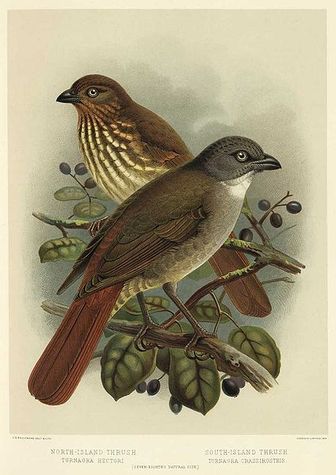Turnagra tanagra
For many years, the North Island Piopio was considered to be conspecific with the South Island Piopio, but the two are now regarded as two separate species due to their pronounced differences in external appearance and apparently also osteology .

Original source: By J. G. Keulemans, in W.L. Buller's A History of the Birds of New Zealand. 2nd edition. Published 1888.Permission(Reusing this file) This file is licensed under the Creative Commons Attribution-Share Alike 3.0 New Zealand license.You are free:to share – to copy, distribute and transmit the work
Author: By J. G. Keulemans, in W.L. Buller's A History of the Birds of New Zealand. 2nd edition. Published 1888.Permission(Reusing this file) This file is licensed under the Creative Commons Attribution-Share Alike 3.0 New Zealand license.You are free:to share – to copy, distribute and transmit the work
The Turnagra tanagra is classified as Extinct (EX), there is no reasonable doubt that the last individual has died.
The North Island Piopio, Turnagra tanagra, was a passerine bird of the Turnagridae family. The North Island Piopio is now considered to be extinct. The Māori names were piopio-kata (also transcribed as tiutiu-kata), and in the Kaipara dialect, korohea. More
Island Turnagra tanagra was so named because it was thought to be related to the tanagers of North America. Little is known about their biology. They frequented the undergrowth and forest floor. Their nests were well constructed cups placed in trees a few metres from the ground, in which two to four eggs were laid. Walter Buller described their calls as being amongst the most beautiful of any New Zealand bird. They were also able to mimic the calls of other birds. More
Summary Turnagra tanagra was endemic to the North Island, New Zealand1. Buller described them as common in the 1870s, but there were few specimens ever collected (specimens are only known to exist in Chicago, Tring, Philadelphia and Wellington), the last being from 19001. Occasional sight records persisted until 19553. Ecology: Very little is known, although it is likely to have required large tracts of primary native forest. More
Turnagra tanagra, Turnagra capensis Petroica macrocephala, Petroica australis Mohoua albicilla, Mohoua novaeseelandiae Megalurus punctatus Rhipidura fuliginosa Zosterops lateralis, Anthornis melanura Prosthemadera novaeseelandiae Notiomystis cincta Acanthisitta chloris, Xenicus gilviventris, Xenicus longipes Bul01BirdP013.jpg Eudynamys taitensis, Gerygone igata Bul01BirdP015.jpg Bul01BirdP016.jpg Bul01BirdP017.jpg Bul01BirdP018. More
Family : Turnagridae
Genus : Turnagra
Species : tanagra
Authority : Dickinson, 2003
